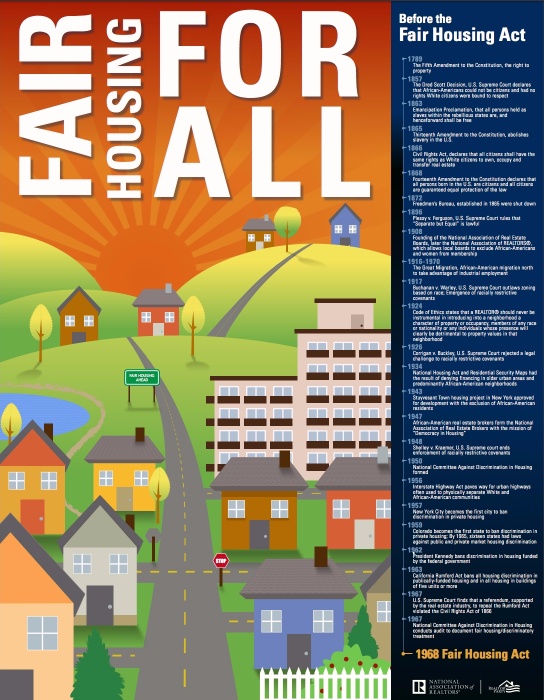
Fair Housing for All
NAR firmly believes in equal opportunity in housing. No person of this country should have the right to rent or purchase shelter of choice abridged because of race, color, religion, sex, handicap, familial status, national origin, sexual orientation, or gender identity. Furthermore, these rights should not be limited because of existing or desired ethnic, racial, or religious proportions in any defined area.
The nation and NAR did not always support fair housing rights. In fact, NAR opposed passage of the Fair Housing Act, and at one time allowed local Associations to exclude members based on race or sex. Our understanding of fair housing rights changed over time and today NAR leads efforts to expand those rights.
1789: Private Property Rights
The Fifth Amendment to the Constitution of the United States protects property rights. Slaves were considered property and had no property rights. Women were not included among those with property rights and military conquest, legislation and court decisions often denied these rights to native Americans of African, Asian, and Latin American decent.
1866: The Civil Rights Act of 1866
Following the Civil War, the Fourteenth Amendment to the Constitution of the United States declares that all persons born in the United States are citizens and the Civil Rights Act of 1866 provides that all citizens have the same rights to real property as do white citizens. Court cases, immigration laws and racially defined zoning denied those rights.
1917: Racial Zoning Outlawed
The Supreme Court of the United States voids zoning based on race. Property owners, real estate interests and local governments then employ deed restrictions based on race and religion to support segregated housing and deny housing based on race, national origin and religion. In 1938 the Women’s Council of REALTORS® was formed and in 1947 African American real estate brokers, many of whom were not allowed to be REALTORS®, formed the National Association of Real Estate Brokers with a fair housing mission.
1948: Restrictive Deed Covenants Not Enforceable
The Supreme Court of the United States ends court enforcement of deed restrictions based on race, religion and national origin. A growing fair housing movement passes the first fair housing laws in New York City and Colorado in the 1950’s. As the Fair Housing movement grows, the Rev. Dr. Martin Luther King, Jr, joins the Chicago Freedom Movement in 1966 to call for fair housing across the country.
1968: Fair Housing Act
The Kerner Commission, studying the civil disorders and causes of riots in US Cities in 1967, wrote that “Our nation is moving toward two societies, one black, one white—separate and unequal.” On April 4, 1968, Dr. Martin Luther King, Jr. was assassinated. President Johnson signed the Fair Housing Act into law on April 11, 1968. The Act states “It is the policy of the United States to provide, within constitutional limitations, for fair housing throughout the United States.” The 1968 Fair Housing Act prohibited discrimination based on race, color, religion and national origin. In 1974, the Fair Housing Act was amended to prohibit discrimination based on sex.
1975: Voluntary Affirmative Marketing Agreement
NAR adopts an agreement with HUD to promote fair housing, educate members regarding their rights and obligations under the Fair Housing Act, develop and recommend fair housing procedures for members and participate in community based fair housing activities. In 1985, NAR supported government funding of testing of fair housing complaints and in 1988, supported expanding the Fair Housing Act to prohibit discrimination based on familial status and handicap or disability. In 2016 NAR resolved to seek changes in the Fair Housing Act to prohibit discrimination based on sexual orientation and gender identity.












